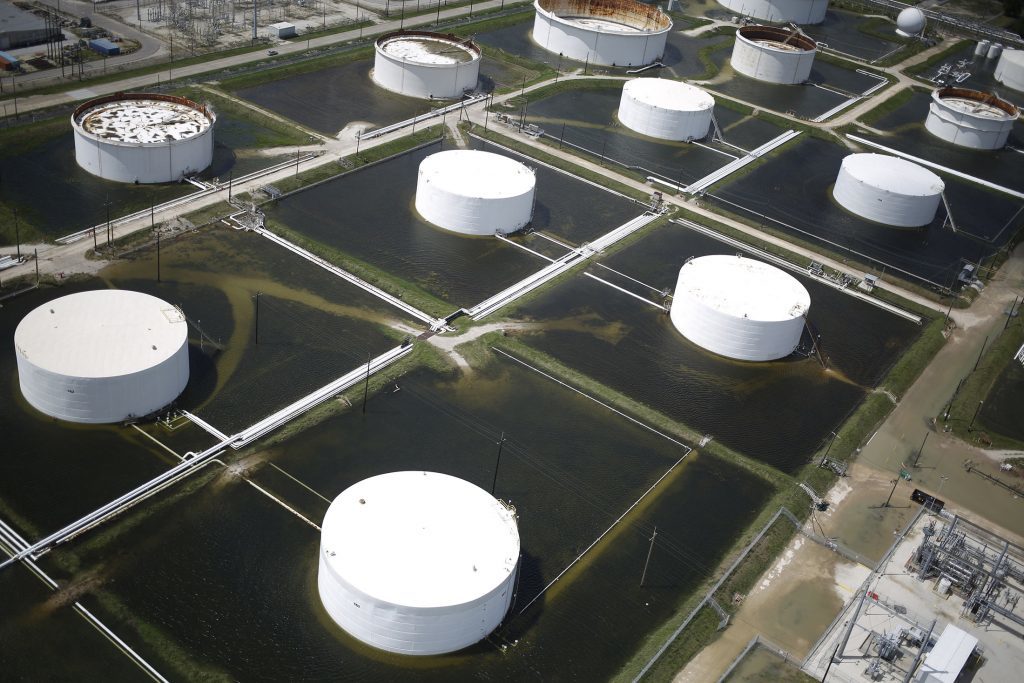
A deadly storm ravaging the Texas and Louisiana coasts has led to a rare release of oil from emergency U.S. stockpiles that President Donald Trump wants to slash.
Just three months ago, Trump proposed selling half the Strategic Petroleum Reserve, which can hold more than 700 million barrels of crude, saying the stockpile was no longer useful in an era of surpluses. On Thursday, as gasoline prices surged, the Energy Department agreed to deliver 1 million barrels from the reserve to a refiner in Louisiana that was unable to get crude after Hurricane Harvey disrupted supplies. It was the first delivery in five years.
“What you saw today was an insurance payout,” Kevin Book, managing director of ClearView Energy Partners in Washington, said of the emergency deliver. “The cost of maintaining that insurance is far, far lower than the value of that insurance in a true moment of scarcity.”
Still, the cost of the strategic reserve is rising, and the storm illustrated the vulnerability of salt caverns along the Gulf of Mexico that the government first developed in 1977. The reserve’s proximity to Gulf Coast refining centers means it can respond to supply disruptions quickly, releasing crude within days of a storm. But they are susceptible to the same risks of hurricanes and storm surges that disrupt supply in the first place.
Operational Challenges
“These are physical sites that have many of the same challenges as all of the other energy infrastructure in the region,” said Chris Smith, who oversaw the Energy Department’s Office of Fossil Energy under President Barack Obama. “Are we going to be able to keep the sites up as the water rises? It’s a challenge to keep the sites operational, particularly with the constraints on funding.”
The Energy Department is undertaking a $2 billion effort to upgrade the reserve’s four storage sites over the next several years. The price tag for improvements and the increased risks from changing coastal conditions are among the reasons opponents want to ditch the reserve.
“The whole infrastructure system has had a really harsh test with Harvey,” said Philip Verleger an economist who led the Treasury Department’s Office of Energy Policy under President Jimmy Carter and is now the head of an eponymous Carbondale, Colorado-based consulting firm. “Four feet of rain is more than anybody thought was possible when they were designing this thing. We won’t know for a month or two what needs to be fixed, and whether it can be fixed.”
Political Fight
Gasoline prices have surged since flooding and winds from Harvey shuttered almost one quarter of U.S. refining capacity and cut off oil deliveries to the region. The Energy Department has offered to ease the supply crunch by providing some of its stockpiled oil. It loaned 1 million barrels to Phillip 66’s Lake Charles refinery in Louisiana. The agreement calls for the Houston-based company to replace the oil once supplies are flowing again.
West Texas Intermediate oil slipped 0.6 percent to $46.95 a barrel as of 12:01 p.m. in Singapore on Friday. Gasoline in New York for October delivery lost 0.4 percent to $1.7729 a gallon. Front-month prices for the motor fuel rose 25 percent in August, the biggest monthly gain in more than a year.
That availability of emergency supplies illustrates the the value of the reserve, said Robert McNally, former energy adviser to President George W. Bush.
“Harvey is a wake-up call,” said McNally, the president of the Bethesda, Maryland-based consulting firm Rapidan Group. “What Harvey shows is that we still need a reserve and that Washington is wrong.”
In May, the White House proposed selling half the crude oil in the strategic reserve and all of its gasoline stockpile. The Trump administration argues that the reserve is a drain on taxpayers. Calls to reduce the stockpile have escalated as domestic crude production soars and imports decline. Congress, meanwhile, has ordered the Energy Department to sell 27 percent of the oil stash to fill government budget holes.
While the reserve was designed to mitigate global supply disruptions, in practice it’s mostly been tapped in the aftermath of major storms such as Hurricane Katrina in 2005. The last time the Energy Department released emergency oil came in 2012, after Hurricane Isaac shut 95 percent of Gulf oil production. The Energy Department also loaned 5 million barrels of oil to Gulf refineries after Hurricanes Gustav and Ike in 2008.
